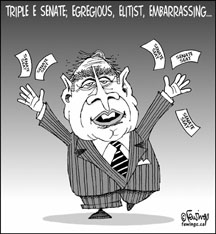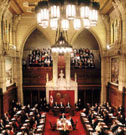A reformed Senate in a Canadian republic .. manifest destinies or impossible dreams?
Nov 30th, 2007 | By Randall White | Category: Canadian Republic
The current quixotic and apparently only half-serious quest for Senate reform in Canada shows both the best and worst sides of the Stephen Harper Conservative minority government in Ottawa. There is a high-minded sense in which this relic of the 19th century desperately ought to be brought up to date, in the interests of a stronger Canadian future. But Mr. Harper is trying to use his clever plans in a much more opportunistically low-minded way, recently prompting the Kitchener-Waterloo Record in Ontario, e.g., to urge that “Senate reform isn’t for threats.”
Last Saturday’s Australian election triumph of Labor leader Kevin Rudd, with his commitment to some eventual further motion towards an Australian republic, also raises a few companion rumblings up here in the true north. The British monarchy is another 19th century relic in both countries. And the latest poll numbers suggest that a majority even in Canada would like to see the end of it soon. Yet here Mr. Harper seems more definitively on the side of the darkness. And this can make you wonder what is really going on with Senate reform (and/or abolition) too.
1. The new abolitionist fall colours …
 The latest fall 2007 wrinkle in the clever Harper Senate reform plans is the prospect of actually abolishing the Senate, if it proves altogether impossible to move ahead with even just the two initial modest “step-by-step” reform measures that the Conservative minority government introduced last year. The new/old/updated plot was nicely summarized by the Ottawa radio station CFRA this past November 13:
The latest fall 2007 wrinkle in the clever Harper Senate reform plans is the prospect of actually abolishing the Senate, if it proves altogether impossible to move ahead with even just the two initial modest “step-by-step” reform measures that the Conservative minority government introduced last year. The new/old/updated plot was nicely summarized by the Ottawa radio station CFRA this past November 13:
“Minister Responsible for Democratic Reform Peter Van Loan is serving notice this is the last chance for reforming the Senate.
“The minority Conservative Government has reintroduced two Senate reform bills in the House of Commons.
 “One bill will impose a term limit of eight years on Senators, while the other will create a process to elect Senators.
“One bill will impose a term limit of eight years on Senators, while the other will create a process to elect Senators.
“The legislation is identical to two Senate reform bills introduced in the last session of Parliament. [I.e., Bills S-4 and C-43.]
“Loan told reporters we are open to different approaches to the details of Senate reform but we will not compromise on one fundamental aspect: the Senate must change. And if that change cannot happen through reform, then we believe that the Senate should be abolished.'”
It would seem that the new openness to just abolishing the 19th century relic of the unreformed Senate of Canada was first broached by Mr. Harper during his Australian trip this past summer.
A vaguely intriguing additional wrinkle here is that federal NDP leader Jack Layton has joined in on the spirit of the new Senate abolition option, and even proposed a cross-Canada referendum on the subject (probably to be held in conjunction with the next federal election). Mr. Harper – perhaps playing a game with the New Democrats he has come to enjoy somewhat? – has seemed to make friendly noises about Mr. Layton’s proposal.
2. Senator Hugh Segal nobly enters the debate …
 This last point is interesting (at least for some of us), because it marks the first time since the introduction of the two Senate reform bills last year that any federal party other than Mr. Harper’s minority Conservatives has shown any enthusiasm for any part of the package. I.e., you might at first think something could actually happen about Senate abolition, with the New Democrats on board.
This last point is interesting (at least for some of us), because it marks the first time since the introduction of the two Senate reform bills last year that any federal party other than Mr. Harper’s minority Conservatives has shown any enthusiasm for any part of the package. I.e., you might at first think something could actually happen about Senate abolition, with the New Democrats on board.
Yet it is the speculations in this same broad context of another figure, in Mr. Harper’s own party, that may have more seriously moved the file ahead a little – in some suitably high-minded and constructive way. The figure in question is Senator Hugh Segal – a traditional noble guru of the old Eastern Progressive Conservative and Red Tory factions, who has also shown a certain enthusiasm for contributing to Mr. Harper’s version of the new Western Reform Conservatism.
 Senator Segal is evidence for the argument that even as presently constituted the unreformed Canadian Senate has some distinction. Hugh Segal has “spent all of my adult life affiliated in some way with the politics of Ontario and Canada,” and made some intelligent and high-minded contributions to this branch of Canadian public life. Though he has been a confirmed (if gentlemanly) Conservative partisan since “the age of 12 when John Diefenbaker spoke at my school in Montreal,” he was appointed to the Senate for the Ontario district of Kingston-Frontenac-Leeds in 2005, by the Liberal Prime Minister Paul Martin.
Senator Segal is evidence for the argument that even as presently constituted the unreformed Canadian Senate has some distinction. Hugh Segal has “spent all of my adult life affiliated in some way with the politics of Ontario and Canada,” and made some intelligent and high-minded contributions to this branch of Canadian public life. Though he has been a confirmed (if gentlemanly) Conservative partisan since “the age of 12 when John Diefenbaker spoke at my school in Montreal,” he was appointed to the Senate for the Ontario district of Kingston-Frontenac-Leeds in 2005, by the Liberal Prime Minister Paul Martin.
Somewhat like NDP leader Jack Layton, Senator Segal has also lately been contemplating the prospect of a popular referendum on the future of the Senate – which would include the abolition of the institution as at least one possible option. Unlike Mr. Layton but like his own party, however, it seems clear that Mr. Segal’s position still holds out reform rather than abolition as a preferred option. As Minister Responsible for Democratic Reform Peter Van Loan has put it, Senator Segal would apparently agree that if “change cannot happen through reform, then we believe that the Senate should be abolished.”
3. Constitutional referendums and provincial approvals …
 One crucial problem with abolishing the Senate, some would stress, is that it cannot be done by the federal government alone. On some views of the sometimes arcane assortment of amending formulae prescribed in the Constitution Act 1982, abolishing the Senate would require the approval of both the federal Senate and House of Commons, and all 10 provincial legislatures. And it is here that Senator Segal has made some rather interesting and constructive contributions to the current debate – in an article published in the November 16 issue of the Ottawa Citizen.
One crucial problem with abolishing the Senate, some would stress, is that it cannot be done by the federal government alone. On some views of the sometimes arcane assortment of amending formulae prescribed in the Constitution Act 1982, abolishing the Senate would require the approval of both the federal Senate and House of Commons, and all 10 provincial legislatures. And it is here that Senator Segal has made some rather interesting and constructive contributions to the current debate – in an article published in the November 16 issue of the Ottawa Citizen.
Without getting into any too vast details, a few paragraphs from this article summarize a quite intriguing and potentially helpful argument:
“To make fundamental changes to our system of government, the Crown, Parliament, or the regular election cycle, the current amendment formula requires the consent of all provincial legislatures and the Parliament of Canada.”
 More particularly, Senator Segal goes on: “In the design of any referendum on the abolition or maintenance of the Senate, it would be of immense value if Ottawa and the provinces would simply agree that the federal government would sign on to an amendment if a 50-per-cent-plus-one majority of Canadians voted for abolition. Any premier would agree to sign on for an amendment if a 50-per-cent-plus-one majority of the voters in his or her province voted for abolition as well.
More particularly, Senator Segal goes on: “In the design of any referendum on the abolition or maintenance of the Senate, it would be of immense value if Ottawa and the provinces would simply agree that the federal government would sign on to an amendment if a 50-per-cent-plus-one majority of Canadians voted for abolition. Any premier would agree to sign on for an amendment if a 50-per-cent-plus-one majority of the voters in his or her province voted for abolition as well.
“Such a clear referendum would allow us to avoid another cycle of reform contortions or the late-night, never-ending first ministers’ conferences where deals might be struck or broken, without clarity from the public as to their wishes …
“One of the core premises of the development of responsible government in Canada is the process of evolution. To be relevant and engaged, all aspects of our democratic institutions must be open to reflection, public scrutiny and public sanction. The Canadian Senate, venerable, thoughtful, constructive and often nonpartisan as it may be, must not be outside the circle of democratic responsibility.”
4. Remembering the nightmare of the Charlottetown Accord …
 To appreciate the fullest significance of what Senator Segal has said here you probably have to at least very briefly go back to the terrible Canadian constitutional nightmare era of the failed Charlottetown Accord of 1992.
To appreciate the fullest significance of what Senator Segal has said here you probably have to at least very briefly go back to the terrible Canadian constitutional nightmare era of the failed Charlottetown Accord of 1992.
In particular again you have to recall that even though the Charlottetown Accord was finally agreed to by both houses of the Parliament of Canada and all 10 provincial legislatures, as required under the Constitution Act 1982, it was also submitted to a cross-Canada referendum of all the people of Canada, even though this was not required according to the strictest written letter of current Canadian constitutional law.
The 1992 Accord involved quite large constitutional changes regarding such matters as Quebec’s place in confederation, Senate reform, aboriginal rights, and so forth, on and on. The federal and provincial politicians and government (and aboriginal) officials who negotiated these constitutional changes felt that, without the kind of popular endorsement a referendum would secure and make clear, the Accord would not have enough of what Hugh Segal has just recently called “public scrutiny and public sanction” to work effectively in practice.
 As it happened, even though the 1992 Charlottetown Accord actually was agreed to by the federal Parliament and all 10 provincial legislatures – which is all that the amending formula in the Constitution Act 1982 strictly and legally requires – it was finally rejected by the people of Canada in the accompanying popular referendum.
As it happened, even though the 1992 Charlottetown Accord actually was agreed to by the federal Parliament and all 10 provincial legislatures – which is all that the amending formula in the Constitution Act 1982 strictly and legally requires – it was finally rejected by the people of Canada in the accompanying popular referendum.
For this reason it is NOT the law of the land today. And, like many others who ponder such things, Senator Segal has apparently come to conclude that this use of referendums in such fundamental constitutional matters has become an important and even crucial precedent in Canada’s “unwritten” constitutional law.
(And unwritten constitutional law can be important in the kind of parliamentary democracy that Canada, like India or Ireland, or Barbados, or Australia, etc., has inherited from across the sea.)
5. The more general dilemmas of constitutional amendment in Canada today …
 To spell out Senator Segal’s insights in a more general way, there are those who say that the key problem with Canada’s still quite youthful constitutional amending formula in the Constitution Act 1982 is that (as Senator Segal puts it, again ): “To make fundamental changes to our system of government, the Crown, Parliament, or the regular election cycle, the current amendment formula requires the consent of all provincial legislatures and the Parliament of Canada.”
To spell out Senator Segal’s insights in a more general way, there are those who say that the key problem with Canada’s still quite youthful constitutional amending formula in the Constitution Act 1982 is that (as Senator Segal puts it, again ): “To make fundamental changes to our system of government, the Crown, Parliament, or the regular election cycle, the current amendment formula requires the consent of all provincial legislatures and the Parliament of Canada.”
As one customary argument these days goes, this is just too stringent a requirement to ever be realized in practice. When was the last time, e.g., that all 10 provincial governments in Canada agreed with the federal government about anything?
Yet here Senator Segal is saying “wait a minute.” Apart from the plain truth that all 10 provincial governments and the federal government actually did agree on the Charlottetown Accord only 15 years ago, the bigger point nowadays is that by the same unwritten constitutional precedent you need approval in a cross-country referendum as well.
 And then Senator Segal is proposing something else here – something that could bring some fundamental democratic discipline to the endless petty squabbling among provincial principalities that sometimes does cast a great pall over almost anything seriously constructive and forward-looking in Canadian public life.
And then Senator Segal is proposing something else here – something that could bring some fundamental democratic discipline to the endless petty squabbling among provincial principalities that sometimes does cast a great pall over almost anything seriously constructive and forward-looking in Canadian public life.
More exactly, Senator Segal says (again): “In the design of any referendum on the abolition or maintenance of [fill in the blanks], it would be of immense value if Ottawa and the provinces would simply agree that the federal government would sign on to an amendment if a 50-per-cent-plus-one majority of Canadians voted for abolition.”
And then (yet again) he goes on: “Any premier would agree to sign on for an amendment if a 50-per-cent-plus-one majority of the voters in his or her province voted for abolition [or whatever else] as well … Such a clear referendum would allow us to avoid another cycle of reform contortions or the late-night, never-ending first ministers’ conferences where deals might be struck or broken, without clarity from the public as to their wishes.”
6. 53% of Canadians now want to abolish the British monarchy in Canada too!
 These vast ruminations are already going on too long. But just to at least start to end quickly enough, it is worth noting that Senator Segal’s suggestions about referendums and provincial agreements, in connection with “the abolition or maintenance of the Senate,”could also be applied to the more efficient future resolution of another particular thorny Canadian constitutional issue.
These vast ruminations are already going on too long. But just to at least start to end quickly enough, it is worth noting that Senator Segal’s suggestions about referendums and provincial agreements, in connection with “the abolition or maintenance of the Senate,”could also be applied to the more efficient future resolution of another particular thorny Canadian constitutional issue.
A September 2007 Angus Reid poll, e.g., has just shown that 53% of Canadians now support “Canada ending its formal ties to the British monarchy,” 35% oppose, and 12% are not sure. And this just continues and even somewhat advances a trend that has been gathering momentum for the past decade or more.
Political debate on the republican option in Canada today is still not quite as developed as it is in Australia. Very few Canadian party politicians are as yet avowed republicans like prime-minister-elect Kevin Rudd in Australia.
 (Partly perhaps because the British monarchy in Canada has been more important as a symbol of anglophone identity in anglophone-francophone conflicts? And on another related front, since 1965 Canada has remained ahead of Australia, in having an independent national flag, that dispenses with the British Union Jack in the top left-hand corner. )
(Partly perhaps because the British monarchy in Canada has been more important as a symbol of anglophone identity in anglophone-francophone conflicts? And on another related front, since 1965 Canada has remained ahead of Australia, in having an independent national flag, that dispenses with the British Union Jack in the top left-hand corner. )
In any case, the September 2007 Angus Reid poll is just a straw in a wind that has been blowing for some time, and is almost certainly getting stronger.
People of so-called British ethnic origins are much less important in Canada demographically than they used to be – and this trend too is bound to grow. Despite assorted fairy tales to the contrary (that do apply no doubt in a few particular cases), the British monarchy has, not surprisingly, never been popular in francophone Quebec, or francophone Canada at large. And in the September 2007 Angus Reid poll, 74% of Quebec respondents supported “Canada ending its formal ties to the British monarchy.”
7. Constitutional referendums and provincial approvals on the British monarchy in Canada …
 There are still those who say that, despite such advancing popular statistics, it will be very hard to actually abolish the British monarchy in Canada, because (as Senator Segal puts it, yet again): “To make fundamental changes to our system of government, the Crown, Parliament, or the regular election cycle, the current amendment formula requires the consent of all provincial legislatures and the Parliament of Canada.”
There are still those who say that, despite such advancing popular statistics, it will be very hard to actually abolish the British monarchy in Canada, because (as Senator Segal puts it, yet again): “To make fundamental changes to our system of government, the Crown, Parliament, or the regular election cycle, the current amendment formula requires the consent of all provincial legislatures and the Parliament of Canada.”
At the same time (and yet again as well), Senator Segal himself has suggested a resolution of the dilemma.
 In the design of any referendum on the abolition of the British monarchy, you might say (and its replacement by a directly or indirectly elected governor general/president, on the current Irish or Indian parliamentary democratic models, e.g.), “it would be of immense value if Ottawa and the provinces would simply agree that the federal government would sign on to an amendment if a 50-per-cent-plus-one majority of Canadians voted for abolition. Any premier would agree to sign on for an amendment if a 50-per-cent-plus-one majority of the voters in his or her province voted for abolition as well.”
In the design of any referendum on the abolition of the British monarchy, you might say (and its replacement by a directly or indirectly elected governor general/president, on the current Irish or Indian parliamentary democratic models, e.g.), “it would be of immense value if Ottawa and the provinces would simply agree that the federal government would sign on to an amendment if a 50-per-cent-plus-one majority of Canadians voted for abolition. Any premier would agree to sign on for an amendment if a 50-per-cent-plus-one majority of the voters in his or her province voted for abolition as well.”
(From this standpoint, some will also want to stress, Canadian republicans are still not quite ready to win a cross-country referendum. Based on the September 2007 Angus Reid poll at least, they would win in Quebec, Manitoba and Saskatchewan, and Atlantic Canada. But they would lose in BC, and it would be an uncertain toss-up in Alberta and Ontario. A few more years of rising poll numbers will have to elapse before a referendum victory is certain in all 10 provinces.)
8. L’envoi … Senate reform if necessary, etc …
 Of course, many of Senator Segal’s fellow Conservative politicians, even today, may be much less open to constitutional referendums about abolishing the monarchy – as opposed to abolishing or reforming the Senate.
Of course, many of Senator Segal’s fellow Conservative politicians, even today, may be much less open to constitutional referendums about abolishing the monarchy – as opposed to abolishing or reforming the Senate.
In some ways these two Canadian constitutional reform objectives are similar. As already alluded to, e.g., both institutions can reasonably be described as aristocratic and elitist relics of the Victorian and “British North American” 19th century, that gave birth to the present confederation in Canada. It is also quite intriguing – if not altogether statistically overwhelming – that in the September 2007 Angus Reid poll respondents who said they would vote Conservative in the next election tended to be somewhat more supportive of abolishing the British monarchy than respondents voting for any other party, with the obvious unsurprising exception of the Bloc Quebecois.
Alas party voters are apparently one thing. Partisan activists and politicians are another. The Conservative Party of Canada is also the only party in the country today that still includes support for Canada’s “constitutional monarchy” in its constitution. The Tories have traditionally been the monarchist party in Canada. Mr. Harper himself has made a variety of comments, on trips to the United Kingdom especially perhaps, that suggest even his version of a Western Reform Conservative Party still chooses to honour this tradition.
On the other hand, you might wonder. Given the way Mr. Harper and his Conservatives have finally tried to use the higher-minded cause of Senate reform for various lower-minded causes of their own, do he and his government really honour any traditions beyond winning elections? What does anyone seriously remember of Canadian history in the early 21 st century anyway (outside at least la belle province in Quebec, which still has the oldest Canadian memories)?
 And this can take you back to the Kitchener-Waterloo Record‘s “Senate reform isn’t for threats” editorial of this past November 17: “The discussion of either reform or abolition of the Canadian Senate is something to be entered into in a mature and reasoned manner, with due deference to the institution … Whatever its merits or demerits, it has been an intrinsic part of the fabric of our parliamentary democracy since Confederation. It is not to be lightly toyed with as though it were a fad of the day. How then does the federal Conservative government justify acting on the contentious issue like a petulant child who pouts: I’m taking my marbles home if you don’t play my way.’ … Specifically, the government is warning members of Parliament to support its efforts to reform the Senate. If they don’t, it’s threatening to do away with the upper chamber.”
And this can take you back to the Kitchener-Waterloo Record‘s “Senate reform isn’t for threats” editorial of this past November 17: “The discussion of either reform or abolition of the Canadian Senate is something to be entered into in a mature and reasoned manner, with due deference to the institution … Whatever its merits or demerits, it has been an intrinsic part of the fabric of our parliamentary democracy since Confederation. It is not to be lightly toyed with as though it were a fad of the day. How then does the federal Conservative government justify acting on the contentious issue like a petulant child who pouts: I’m taking my marbles home if you don’t play my way.’ … Specifically, the government is warning members of Parliament to support its efforts to reform the Senate. If they don’t, it’s threatening to do away with the upper chamber.”
But then again there is Senator Segal’s intriguing and possibly quite helpful Conservative argument about referendums and provincial approvals, which can apply to reforming or abolishing the Senate – and perhaps even, eventually, to abolishing the tired old British monarchy in Canada too. So perhaps it’s still not quite time to give up on higher-minded views of Canada and its strongest longer-term future just yet.
A reformed Senate in a new forward-looking Canadian republic may just be impossible dreams. But they certainly make as much sense as endless investigations of Karlheinz Schreiber and Brian Mulroney, and the so-called sponsorship scandal (or “Adscam”) – going all the way back to the congenially (and no doubt understandably) alcoholic founding father, John A. Macdonald, and the Pacific Scandal of the early 1870s.
What we do seem to have now is more like “Senate reform if necessary, but not necessarily Senate reform.” (To echo the old Incredible Canadian Liberal prime minister of the first half of the 20th century, who everyone in Toronto thought was appalling when he was alive too.) And who knows? Maybe it is at least the start of something a little bigger, at last? (And maybe even Stephane Dion, and Michael Ignatieff, and Bob Rae, and Gerard Kennedy, and especially Ken Dryden and John Manley, etc, etc, should join at least some very non-partisan and high-minded version of the party too?)
Randall White is the author of a number of books on Canadian history and politics, including Voice of Region: The Long Journey to Senate Reform in Canada, and Is Canada Trapped in a Time Warp? : Political Symbols in the Age of the Internet.
* * * *
UPDATE AUGUST 2009: Two more recent opinion polls have confirmed the dwindling popularity of the British monarchy in Canada.
In a February 2008 Angus Reid Strategies survey 55% of respondents supported Canada’s ending its formal ties to the offshore theoretical head of state, up from 53% in September 2007, while 34% opposed, down from 35%. Respondents “Not sure” in February 2008 were 11%, down from 12% in September 2007.
A Strategic Counsel survey just before Canada Day 2009 found that the “monarchy is a bust with today’s Canadians. When asked if they felt a stronger connection to the Queen or the Queen’s representative, Governor-General Michaëlle Jean, 20 per cent named the Queen, 10 per cent said the G-G – and a remarkable 70 per cent said ‘neither’… when asked to look beyond the [still] relatively popular Queen, 65 per cent of Canadians thought the ties to the Crown should be severed once she passes. Only 35 per cent care to think of Prince Charles, who will visit here this fall, as a future king of Canada.” According to the Strategic Counsel’s Peter Donolo: “We were frankly surprised by the depth of the desire to cut ties with the monarchy.”
For more recent developments on Senate reform in Canada, see: “Does the Coalition have a future?” ; “Look who’s supporting Senate reform in Canada now!” ; and “What Canadian politician said ‘We don’t support any Senate appointments’?.”

